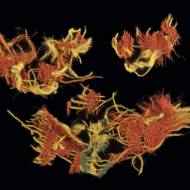
New research showing evidence of the use of plant dyes in textiles dating back to Kings David and Solomon contradicts previous assumptions that furnaces in the heart of the desert were operated by slaves.
A joint study by the Israel Antiquities Authority, Tel Aviv University, and Bar-Ilan University has discovered dyestuff used for textiles from the time of Kings David and Solomon at Timna in the south. The find provides the earliest evidence of a plant-based dye in Israel.
The research, showing evidence of the use of plant dyes in the Land of Israel thousands of years ago, was published Wednesday in the prestigious journal PLOS ONE. The project was led by Dr. Naama Sukenik of the Israel Antiquities Authority and Dr. Erez Ben-Yosef of Tel Aviv University, in cooperation with a research team from Tel Aviv University, Bar-Ilan University and the Israel Antiquities Authority.
Excavations conducted since 2013 in the Timna Valley, directed by Ben-Yosef, have recovered dozens of fragments of 3,000-year-old textiles, which were preserved thanks to the region’s extremely arid climate. The textiles, some decorated with a red-and-blue bands pattern, date to the early Iron Age (12th – 10th centuries BCE), during the era of the biblical Kings David and Solomon.
These are the earliest examples of plant-based dyes in the country and in the Levant (the eastern Mediterranean). The dyes were identified at the Bar-Ilan University laboratories using HPLC advanced analytical equipment. On analysis, the data indicated the use of two main plants: Madder, whose roots provided a red dye, and indigotin – probably produced from woad – which was used as a blue dye in a long and complex process involving reduction and oxidization that lasted a number of days.
Both these plants are among the best-known plant dyes in the ancient world. Once grown specifically for dyeing in the Land of Israel, their use continued up to the discovery of synthetic colors. The textiles from Timna were colored with true dye, which is characterized by a chemical bond between dye and fiber, attesting to professional knowledge and skill in the art of dyeing during this period.
The colored woolen textiles came as a surprise to the researchers, since during the Iron Age Timna was principally an important smelting and mining site for the production of copper. According to Ben-Yosef and Sukenik, “The findings indicate that the society at Timna, identified with the Kingdom of Edom, was hierarchical and included an upper class that had access to colorful, prestigious textiles.”
The context in which the textiles were found suggests that the metalworkers responsible for operating the smelting furnaces were members of this class.
The task of turning stone into copper demanded considerable skill. It was one of the most specialized crafts of the ancient world, and the metalworkers apparently enjoyed high social status and wore distinctive, colored garments. In this sense, the findings are a real innovation, since they contradict the previous research supposition that the furnaces in the heart of the desert were operated by slaves.
Courtesy: GPO and Israel Antiquities Authority
Subscribe to Our FREE Newsletter for More Great Stories Like This One
United with Israel publishes stories like this every day. We believe that our work allows a more balanced view of Israel to emerge. With so much anti-Israel media bias out there from outlets like CNN and the BBC, helping the Holy Land means getting our message out to as many people as possible.
You can help.
Subscribe to our free newsletter to ensure that you get the latest and best stories from United with Israel. Together we can make a difference, and it starts with communication.
CLICK HERE TO SUBSCRIBE TO OUR FREE NEWSLETTER
Source: United with Israel


